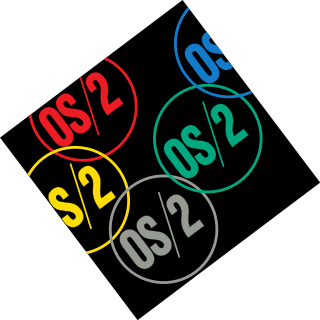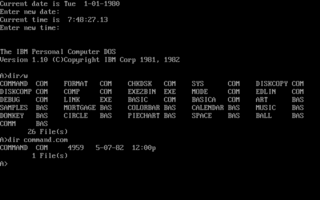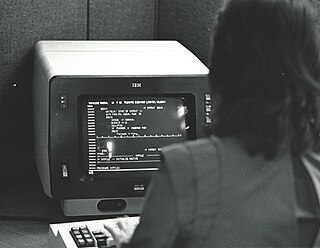Related Research Articles

OS/2 is a series of computer operating systems, initially created by Microsoft and IBM under the leadership of IBM software designer Ed Iacobucci. As a result of a feud between the two companies over how to position OS/2 relative to Microsoft's new Windows 3.1 operating environment, the two companies severed the relationship in 1992 and OS/2 development fell to IBM exclusively. The name stands for "Operating System/2", because it was introduced as part of the same generation change release as IBM's "Personal System/2 (PS/2)" line of second-generation personal computers. The first version of OS/2 was released in December 1987 and newer versions were released until December 2001.

WordStar is a word processor application for microcomputers. It was published by MicroPro International and originally written for the CP/M-80 operating system, with later editions added for MS-DOS and other 16-bit PC OSes. Rob Barnaby was the sole author of the early versions of the program.

IBM PC DOS, an acronym for IBM Personal Computer Disk Operating System, is a discontinued disk operating system for the IBM Personal Computer, its successors, and IBM PC compatibles. It was manufactured and sold by IBM from the early 1980s into the 2000s. Developed by Microsoft, it was also sold by that company as MS-DOS. Both operating systems were identical or almost identical until 1993, when IBM began selling PC DOS 6.1 with new features. The collective shorthand for PC DOS and MS-DOS was DOS, which is also the generic term for disk operating system, and is shared with dozens of disk operating systems called DOS.

CP/M-86 is a discontinued version of the CP/M operating system that Digital Research (DR) made for the Intel 8086 and Intel 8088. The system commands are the same as in CP/M-80. Executable files used the relocatable .CMD file format. Digital Research also produced a multi-user multitasking operating system compatible with CP/M-86, MP/M-86, which later evolved into Concurrent CP/M-86. When an emulator was added to provide PC DOS compatibility, the system was renamed Concurrent DOS, which later became Multiuser DOS, of which REAL/32 is the latest incarnation. The FlexOS, DOS Plus, and DR DOS families of operating systems started as derivations of Concurrent DOS as well.
In computing, Interactive System Productivity Facility (ISPF) is a software product for many historic IBM mainframe operating systems and currently the z/OS and z/VM operating systems that run on IBM mainframes. It includes a screen editor, the user interface of which was emulated by some microcomputer editors sold commercially starting in the late 1980s, including SPF/PC.
4DOS is a command-line interpreter by JP Software, designed to replace the default command interpreter COMMAND.COM in Microsoft DOS and Windows. It was written by Rex C. Conn and Tom Rawson and first released in 1989. Compared to the default, it has a large number of enhancements.

DOSKEY is a command for DOS, IBM OS/2, Microsoft Windows, and ReactOS that adds command history, macro functionality, and improved editing features to the command-line interpreters COMMAND.COM and cmd.exe.

XEDIT is a visual editor for VM/CMS using block mode IBM 3270 terminals.

Norton Utilities is a utility software suite designed to help analyze, configure, optimize and maintain a computer. The latest version of the original series of Norton Utilities is Norton Utilities 16 for Windows XP/Vista/7/8 was released 26 October 2012.

Microsoft Diagnostics (MSD) was a software tool developed by Microsoft to assist in the diagnostics of 1990s-era computers. Users primarily deployed this tool to provide detailed technical information about the user's software and hardware and to print the gathered information, usually for use by support technicians in troubleshooting and resolving problems. The assumptions made by the program were valid until the late 1990s: it does not handle plug-and-play USB or other new technologies that appeared around 2000.
Take Command Console (TCC), formerly known as 4DOS for Windows NT (4NT), is a command-line interpreter by JP Software, designed as a substitute for the default command interpreter in Microsoft Windows, CMD.EXE.
SPF/PC is an MS-DOS-based text editor and file manager designed to have an interface that was familiar to those using mainframe SPF and ISPF.
SlickEdit, previously known as Visual SlickEdit, is a cross-platform commercial source code editor, text editor, and Integrated Development Environment developed by SlickEdit, Inc. SlickEdit has integrated debuggers for GNU C/C++, Java, WinDbg, Clang C/C++ LLDB, Groovy, Google Go, Python, Perl, Ruby, Scala, PHP, Xcode, and Android JVM/NDK. SlickEdit includes such features as built in "beautifiers" that can enhance code as you type, code navigation, context tagging, symbol references, third party tool integration, DiffZilla, syntax highlighting, and 15 emulations.

Brief, is a once-popular programmer's text editor in the 1980s and early 1990s. It was originally released for MS-DOS, then IBM OS/2 and Microsoft Windows. The Brief interface and functionality live on, including via the SourceForge GRIEF editor.
GNU Emacs is a free software text editor. It was created by GNU Project founder Richard Stallman, based on the Emacs editor developed for Unix operating systems. GNU Emacs has been a central component of the GNU project and a flagship project of the free software movement. Its tag line is "the extensible self-documenting text editor."

LEXX is a text editor which was possibly the first to use live parsing and colour syntax highlighting. It was written by Mike Cowlishaw of IBM in 1985. The name was chosen because he wrote it as a tool for lexicographers, during an assignment for Oxford University Press's 'New Oxford English Dictionary'. The program ran on mainframes under VM/CMS. LEXX's design was based on several other editors written by the same author augmented by the ability to dynamically parse text and display colour on the new colour terminals that had recently become available. It was programmable using dynamically-loaded compiled commands or using interpreted commands.

DOS is a family of disk-based operating systems for IBM PC compatible computers. The DOS family primarily consists of Microsoft's MS-DOS and a rebranded version, IBM PC DOS, both of which were introduced in 1981. Later compatible systems from other manufacturers include DR-DOS (1988), ROM-DOS (1989), PTS-DOS (1993), and FreeDOS (1998). MS-DOS dominated the IBM PC compatible market between 1981 and 1995.

A scripting language or script language is a programming language that is used to manipulate, customize, and automate the facilities of an existing system. Scripting languages are usually interpreted at runtime rather than compiled.

Rexx is a programming language that can be interpreted or compiled. It was developed at IBM by Mike Cowlishaw. It is a structured, high-level programming language designed for ease of learning and reading. Proprietary and open source Rexx interpreters exist for a wide range of computing platforms; compilers exist for IBM mainframe computers.

A command-line interface (CLI) is a means of interacting with a computer program by inputting lines of text called command-lines. Command-line interfaces emerged in the mid-1960s, on computer terminals, as a user-friendly alternative to punched cards.
References
- ↑ "PC DOS Version 6.10". 16bitos.com. Archived from the original on 2007-04-03. Retrieved 2007-04-03.
- ↑ "PC DOS Version 7.0". 16bitos.com. Archived from the original on 2007-04-03. Retrieved 2007-04-03.
- ↑ "IBM PC DOS Version 7 (Announcement)". ibm.com. 1995-02-28. Archived from the original on 2022-05-14. Retrieved 2022-05-15.
IBM's E Editor: 'Easy editing of one or more files is at your fingertips with the improved E Editor.'
- ↑ "PC DOS 2000". 16bitos.com. Archived from the original on 2007-04-03. Retrieved 2007-04-03.
- ↑ Davis Foulger. "Software Prototypes and Implementations". Archived from the original on 2006-07-17. Retrieved 2007-01-12.
- ↑ Davis Foulger. "Software Prototypes and Implementations". Archived from the original on 2006-07-17. Retrieved 2007-01-12.
- ↑ "Leadership". SlickEdit, Inc. Archived from the original on 2007-01-03. Retrieved 2007-01-16.
- ↑ "Preface - Acknowledgements". Archived from the original on 2003-07-11. Retrieved 2007-06-25.
{{cite web}}: CS1 maint: bot: original URL status unknown (link)